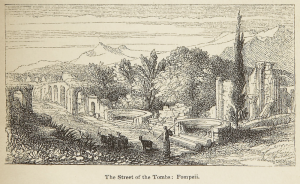Charles Dickens, always fascinated by volcanoes, climbed excitedly to the brim of Mount Vesuvius and peered into the “hell of boiling fire below.” He came away with his clothes alight in a dozen places. The volcano was in the midst of a mini-eruption. Others were killed by Mount Vesuvius so Dickens really did take his life into his hands by braving the journey. According to Clare Tomalin, however, he travelled back to Naples “giddy, singed, scorched and triumphant.”

Climbing to the crater of a volcano may have seemed easy to the great writer after dealing with the dirt, decay, and the flea-ridden accommodation he found in Italy. The hot sun and mosquitoes also drove him mad. Yet he grew to love the country and the animated people and returned for a second visit years later. People in some areas of Italy remember this and they’re holding celebrations for this 200th anniversary of Dickens’s birth.
The novelist set out for Italy with a party of twelve in 1844 when he was in his thirties. His group included his wife and her sister, his five children, and several servants. They planned to live in the country for two years. Although he was an extremely intrepid man, Dickens must have found the prospect of traveling with such a large party daunting in a country where little English was spoken. He hired a French courier to help with the logistics. The Frenchman assisted with customs, hiring horses, and coping with grasping inn-owners.
He chose to stay in Genoa, a city which shocked and dismayed him at first. Dickens found himself overcome by filth, squalid passages, and dirty houses. He never thought that one day he would feel “an attachment for the very stones in the streets of Genoa.”
Dickens found his first house in Genoa, the Villa Bagnerello, unsatisfactory even though it overlooked the bay, green vineyards, and a ruined chapel. He nicknamed the villa, the “Pink Jail.” His second villa, the Palazzo Peschiere, was much more to his liking. Here he lived like a lord in an old palace decorated with marble and murals, which had beautiful terraced gardens. He hadn’t been on a holiday since he was 12 and he was now over 30 so he was happy to enjoy the luxurious palace which was available at a cheap price. He tasted delicious Genoese dishes, enjoyed watching the animated Italian people, and decided that Genoa was a city that “grows upon you.”
The young writer found many aspects of his trip disheartening. He disliked the great contrasts between rich and poor, for example. He saw streets filled with palaces and watched the wealthy living lives of great luxury and travelling in sedan chairs pulled by servants. However, houses in terrible states of disrepair lined the narrow streets of the poor and he found himself assailed by constant beggars.
Naples was especially bad. Here he found “depravity, degradation, and wretchedness.” But he also liked the constant activity – people ate macaroni at sunset and flower-sellers sold their flowers all day. The shining bay and the trip to Capri were stunningly beautiful.
Dickens enthused about Verona and Venice in his book. He read Romeo and Juliet again in Verona and found it easy to imagine a great medieval feud taking place there. He admired the palaces, the charming country, and the “balustraded galleries.” He also found the huge Roman amphitheatre interesting. He nicknamed the town, “pleasant Verona.”
He felt as if he was in a delightful dream in Venice. Here he enjoyed drifting along the Grand Canal, seeing the great cathedral and the churches, and sipping coffee in St Mark’s Square. He gives Venice high praise.
Dickens’s love-hate relationship with Italy is again apparent in Rome, however. He thought that the beauty of the Colosseum by moonlight was difficult to surpass, admired the paintings and the palaces, and felt that he trod in the footsteps of the ancients when he walked amongst the ruins. However, he found it difficult to deal with the poverty and the dirt in the great European city.
He also found some of the ways of the country barbaric. He witnessed a public execution by guillotine in Rome. To Dickens’s astonishment, this was even watched by some women. The criminal had robbed and beaten to death a Bavarian countess who was a pilgrim. He describes the execution in graphic detail.
"Pictures from Italy" is a wonderful book to read before going to Italy. However, Dickens’s anti-Catholicism and description of the execution might upset some readers.





